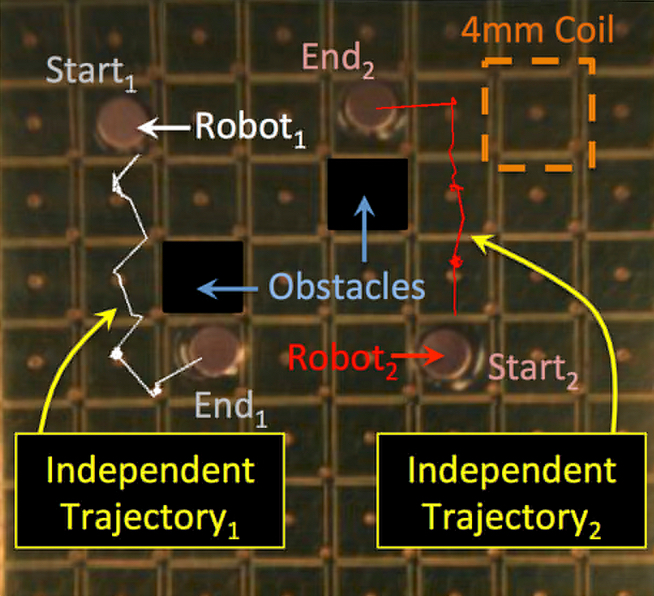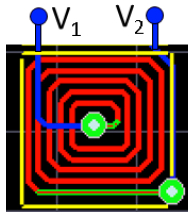Microbots individually controlled using magnetic fields
January 15, 2016

This image shows how two microbots can be independently controlled when operating within a group. (Purdue University image/David Cappelleri)
Purdue University researchers have developed a method to use magnetic fields to independently control individual microrobots operating within groups.
The design allows for each microbot to work independently while operating in groups, similar to how ants work. Until now, it was generally only possible to control groups of microbots to move generally in unison, said David Cappelleri, an assistant professor of mechanical engineering at Purdue.

The magnetic coils were made by printing a copper pattern with the same technology used to manufacture printed circuit boards. (credit: Sagar Chowdhury et al./Micromachines)
The solution: an array of tiny coils that generate attractive or repulsive magnetic forces to move the microbots, which are magnetic disks that slide across the surface. (The microbots are currently about 2 millimeters in diameter, but the researchers plan to create microbots that are around 250 micrometers, 0.25 millimeters, in diameter.)
Applications could include microelectromechanical systems for additive manufacturing, cell sorting, cell manipulation, and cancer cell detection in a biopsy (cancer cells have different stiffness characteristics than non-cancer cells), Cappelleri said.
The National Science Foundation funded the research, which was described in an open-access paper appearing this month in the journal Micromachines.
Purdue University | Localized Magnetic Field Control for Microrobots
Abstract of Towards Independent Control of Multiple Magnetic Mobile Microrobots
In this paper, we have developed an approach for independent autonomous navigation of multiple microrobots under the influence of magnetic fields and validated it experimentally. We first developed a heuristics based planning algorithm for generating collision-free trajectories for the microrobots that are suitable to be executed by an available magnetic field. Second, we have modeled the dynamics of the microrobots to develop a controller for determining the forces that need to be generated for the navigation of the robots along the trajectories at a suitable control frequency. Next, an optimization routine is developed to determine the input currents to the electromagnetic coils that can generate the required forces for the navigation of the robots at the controller frequency. We then validated our approach by simulating an electromagnetic system that contains an array of sixty-four magnetic microcoils designed for generating local magnetic fields suitable for simultaneous independent actuation of multiple microrobots. Finally, we prototyped an m m -scale version of the system and present experimental results showing the validity of our approach.